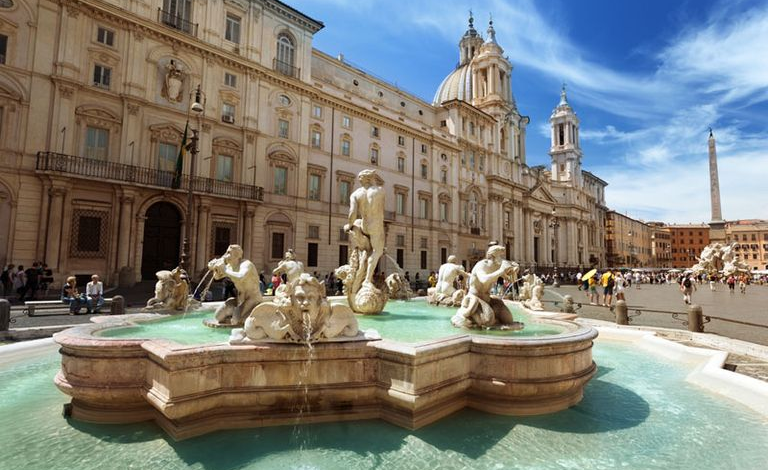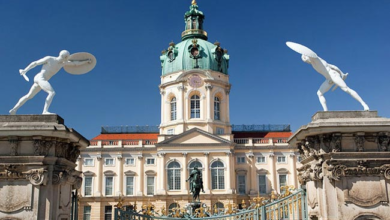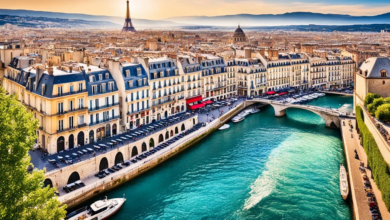Exploring Rome: Travel and Tourism Guide with Essential Tips

Introduction
Rome, the Eternal City, is a captivating blend of ancient history, vibrant culture, and modern energy. Whether you’re visiting for tourism or business, Rome offers an array of experiences that cater to all interests. This guide provides an overview of must-see attractions, travel tips, and essential advice for making the most of your time in this iconic city.
Getting to Rome
By Air
Rome is served by two major airports:
- Leonardo da Vinci-Fiumicino Airport (FCO): The main international gateway, located about 32 km (20 miles) from the city center.
- Ciampino Airport (CIA): Smaller and mainly used by budget airlines, located about 15 km (9 miles) southeast of the city.
From these airports, you can reach the city center by train, bus, taxi, or private transfer.
By Train
Rome’s central railway station, Termini Station, is well-connected to major cities across Italy and Europe. High-speed trains like Trenitalia’s Frecciarossa and Italo provide efficient services to and from Rome.
By Road
If you’re driving to Rome, be prepared for heavy traffic and limited parking in the city center. Consider using park-and-ride facilities on the outskirts and taking public transport into the heart of the city.
Getting Around Rome
Public Transport
Rome’s public transport system includes buses, trams, and the Metro:
- Metro: Three lines (A, B, and C) that cover major areas of the city.
- Buses and Trams: Extensive network operated by ATAC, covering areas not served by the Metro.
Taxis and Ride-Sharing
Taxis are readily available but can be expensive. Ensure they are licensed (white cars with a taxi sign on the roof). Ride-sharing services like Uber are also available.
Walking and Cycling
Rome’s historic center is best explored on foot. Bicycles and electric scooters are available for hire, offering a convenient and eco-friendly way to get around.
Accommodation in Rome
Luxury Hotels
- Hotel de Russie
- Overview: A luxurious hotel near Piazza del Popolo, known for its elegant rooms and beautiful gardens.
- Amenities: Spa, fine dining, and rooftop terrace.
- The St. Regis Rome
- Overview: Offers opulent accommodations and impeccable service in a historic setting near Via Veneto.
- Amenities: Butler service, gourmet restaurant, and fitness center.
Mid-Range Hotels
- NH Collection Roma Palazzo Cinquecento
- Overview: Modern hotel near Termini Station, perfect for business travelers and tourists.
- Amenities: Rooftop terrace, fitness center, and free Wi-Fi.
- Hotel Artemide
- Overview: Centrally located on Via Nazionale, offering comfortable rooms and excellent service.
- Amenities: Spa, restaurant, and complimentary minibar.
Budget Accommodations
- The Beehive
- Overview: Eco-friendly hostel with a cozy atmosphere, located near Termini Station.
- Amenities: Shared kitchen, garden, and free Wi-Fi.
- Generator Rome
- Overview: Stylish hostel offering budget-friendly dorms and private rooms.
- Amenities: Bar, café, and social events.
Must-See Attractions
Historic Landmarks
- The Colosseum
- Overview: Ancient amphitheater and symbol of Rome’s imperial past.
- Highlights: Gladiator tours, underground chambers, and panoramic views from the upper tiers.
- The Roman Forum
- Overview: The heart of ancient Rome, filled with ruins of temples, basilicas, and public spaces.
- Highlights: Arch of Titus, Temple of Saturn, and the Via Sacra.
- The Pantheon
- Overview: A marvel of ancient engineering, with a magnificent dome and oculus.
- Highlights: The tomb of Raphael, the portico, and the dome.
Cultural Sites
- Vatican City
- Overview: The spiritual and administrative center of the Roman Catholic Church.
- Highlights: St. Peter’s Basilica, the Vatican Museums, and the Sistine Chapel.
- Piazza Navona
- Overview: A lively square with beautiful baroque architecture and fountains.
- Highlights: Fountain of the Four Rivers, Church of Sant’Agnese in Agone, and street artists.
- Trevi Fountain
- Overview: Iconic baroque fountain where visitors toss coins to ensure their return to Rome.
- Highlights: Sculptures of Oceanus and the surrounding mythological figures.
There are several popular day trips and excursions from Rome that I would recommend for tourists. Here are a few options:
- Vatican City: While technically an independent country, Vatican City is located within Rome and is a must-visit destination for its famous attractions such as St. Peter’s Basilica, the Vatican Museums (including the Sistine Chapel), and the Vatican Gardens.
- Pompeii and Mount Vesuvius: Take a day trip to the ancient city of Pompeii, which was buried by the eruption of Mount Vesuvius in 79 AD. Explore the well-preserved ruins and learn about life in ancient Rome. You can also hike up Mount Vesuvius for a stunning view of the surrounding area.
- Tivoli: Located about 30 kilometers east of Rome, Tivoli is known for its beautiful gardens and historical villas. Visit Villa d’Este, famous for its Renaissance gardens and stunning fountains, or explore the ruins of Hadrian’s Villa, an impressive Roman villa complex.
- Ostia Antica: This archaeological site is located just outside Rome and was once the bustling port town of ancient Rome. Explore the well-preserved ruins, including the amphitheater, public baths, and marketplaces, to get a glimpse into daily life in ancient Rome.
- Florence: While Florence deserves more than just a day trip, it is possible to take a high-speed train from Rome and spend a day exploring this picturesque city. Visit the famous Duomo, the Uffizi Gallery, and stroll across the Ponte Vecchio.
- Orvieto: Situated in the Umbria region, Orvieto is known for its stunning cathedral and charming medieval streets. Take a guided tour of the Cathedral of Orvieto, admire the beautiful frescoes, and enjoy the scenic views from the town’s elevated position.
- Capri: A visit to the island of Capri is a great option for a day trip from Rome. Take a ferry from Naples and explore the island’s natural beauty, including the famous Blue Grotto, the stunning Faraglioni rock formations, and the picturesque town of Anacapri.
These are just a few examples of the many day trips and excursions available from Rome. Depending on your interests, you can choose among various options to explore the rich history, art, and natural beauty of the surrounding areas.

For first-time visitors to Rome, I would recommend the following day trip options:
- Vatican City: Since Vatican City is located within Rome, it’s a convenient and essential destination to visit. Explore St. Peter’s Basilica, marvel at the intricate artwork in the Vatican Museums (including the Sistine Chapel), and soak in the grandeur of this spiritual and historical site.
- Colosseum and Ancient Rome: While not technically a day trip, a visit to the Colosseum and the ancient Roman Forum is a must for first-time visitors. These iconic landmarks offer a glimpse into the grandeur of the Roman Empire. Consider joining a guided tour to learn about their historical significance.
- Pompeii and Mount Vesuvius: This day trip allows you to experience the tragic history of Pompeii, an ancient city frozen in time by the eruption of Mount Vesuvius. Walking through the remarkably preserved ruins provides a unique insight into daily life in ancient Rome. You can also hike up Mount Vesuvius for a memorable panoramic view.
These three options provide a well-rounded introduction to Rome’s rich history, art, and culture. Vatican City showcases the religious and artistic heritage, while the Colosseum and Ancient Rome offer a glimpse into the city’s ancient past. A day trip to Pompeii and Mount Vesuvius takes you outside of Rome to witness the fascinating remains of an ancient civilization.
If you have limited time as a first-time visitor to Rome, I would recommend focusing on a day trip to the Colosseum and Ancient Rome. This option allows you to explore the iconic Colosseum, which is a symbol of Rome’s ancient grandeur, and visit the nearby Roman Forum, where you can immerse yourself in the fascinating ruins of the ancient city.
By choosing this day trip, you can prioritize the most significant historical and cultural sites in Rome within a relatively short timeframe. The Colosseum is an architectural marvel and one of the most recognizable landmarks in the world. Exploring its interior and learning about the gladiatorial spectacles and events that took place there will give you a profound understanding of ancient Roman culture.
Adjacent to the Colosseum, the Roman Forum offers a vast archaeological site with ruins of temples, basilicas, and government buildings. It was the center of social, political, and commercial life in ancient Rome. Walking through the Forum’s ancient streets, you can imagine the bustling activity that once took place there.
While there are other fantastic day trip options from Rome, such as Vatican City or Pompeii and Mount Vesuvius, focusing on the Colosseum and Ancient Rome allows you to make the most of your limited time while still immersing yourself in Rome’s rich history and cultural heritage.
During your Colosseum and Ancient Rome day trip, there are several key highlights you should focus on to make the most of your visit. Here are the main attractions to prioritize:
- Colosseum: Begin your day trip at the Colosseum, one of the most iconic landmarks in Rome. Explore its impressive architecture, step inside the amphitheater, and imagine the grand spectacles that once took place there. Learn about the history of gladiators, wild animal fights, and public spectacles that entertained ancient Romans.
- Roman Forum: Adjacent to the Colosseum, the Roman Forum offers a vast archaeological site with numerous ruins. Stroll through the ancient streets and explore the temples, basilicas, and government buildings that once thrived in this bustling center of ancient Rome. Highlights include the Temple of Saturn, the Arch of Titus, and the Senate House.
- Palatine Hill: Located next to the Roman Forum, Palatine Hill offers panoramic views of the surrounding area and is the legendary birthplace of Rome. Wander through the ruins of imperial palaces and gardens, and imagine the opulent lifestyle of Roman emperors.
- Arch of Constantine: As you exit the Colosseum, take a moment to admire the impressive Arch of Constantine. This triumphal arch commemorates Emperor Constantine’s victory and is adorned with intricate reliefs depicting scenes from Roman history.
- Capitoline Hill: While not part of the Colosseum and Ancient Rome complex, Capitoline Hill is nearby and worth a visit if you have time. It is one of Rome’s seven hills and houses the Capitoline Museums, which display a vast collection of ancient Roman art and artifacts.
By focusing on these key highlights, you’ll have a comprehensive experience of ancient Rome’s most significant sites. Remember to consider joining a guided tour or audio guide to gain deeper insights into the historical and cultural significance of each attraction.

Exploring the Colosseum and Roman Forum on a self-guided tour can be a rewarding experience. Here are some tips to make the most of your visit:
- Pre-book tickets: The Colosseum is a popular attraction, and it’s recommended to pre-book your tickets online to avoid long queues. Consider purchasing a combined ticket that includes access to the Colosseum, Roman Forum, and Palatine Hill.
- Arrive early or late: To avoid the crowds, try to arrive early in the morning or later in the afternoon. This way, you can enjoy the sites with fewer people and have a more immersive experience.
- Bring a guidebook or use a reliable audio guide app: A good guidebook or audio guide app can provide historical context and detailed information about the Colosseum and Roman Forum. It’s helpful to have a resource that explains the significance of the different structures and points of interest.
- Rent an audio guide on-site: If you prefer an audio guide, you can rent one at the Colosseum. These devices provide commentary and explanations as you explore the site at your own pace.
- Take advantage of informational signs: Throughout the Colosseum and Roman Forum, you’ll find informational signs that provide insights into the history and significance of various structures. Take your time to read these signs to enhance your understanding of the sites.
- Plan your route: Before your visit, familiarize yourself with the layout of the Colosseum and Roman Forum. Plan a route that allows you to see the main highlights, such as the Colosseum’s interior, the Arch of Constantine, key temples in the Roman Forum, and the viewpoints on Palatine Hill.
- Allow ample time: The Colosseum and Roman Forum are extensive sites, and it’s advisable to allocate a significant amount of time for your visit. Plan for at least a few hours to explore the attractions thoroughly.
- Pack essentials: Ensure you have comfortable walking shoes, sunscreen, a hat, and a water bottle, as the sites can be exposed to the sun and involve a fair amount of walking.
Remember, while a self-guided tour allows for flexibility, joining a guided tour led by an expert can provide deeper insights and a more comprehensive understanding of the history and significance of these ancient sites.
When exploring the Colosseum and Roman Forum, there are several must-see highlights that you should prioritize. Here are the key attractions within each site:
Colosseum:
- Arena Floor: The central stage where gladiatorial contests and other spectacles took place. Walk on the same ground where ancient warriors once fought.
- Underground Hypogeum: Descend into the underground chambers to see where animals and gladiators were kept before their battles.
- First and Second Levels: Explore the different levels of the Colosseum to appreciate the architectural grandeur and enjoy panoramic views of the surrounding area.
- Arch of Constantine: Located just outside the Colosseum, this triumphal arch commemorates Emperor Constantine’s victory and is adorned with intricate reliefs.
Roman Forum:
- Temple of Saturn: One of the oldest structures in the Forum, this temple was dedicated to the Roman god Saturn. Its impressive columns and ruins are worth exploring.
- Arch of Titus: This triumphal arch celebrates Emperor Titus’s victory in the Jewish War and features detailed reliefs depicting scenes from the war and the spoils of Jerusalem.
- Basilica of Maxentius and Constantine: Admire the immense ruins of this basilica, which was once the largest building in the Roman Forum. Marvel at its impressive architecture and towering columns.
- Temple of Vesta: Visit the circular temple dedicated to the goddess Vesta, which housed the sacred hearth flame of Rome.
- Curia Julia: The Senate House of ancient Rome, where important political decisions were made. Explore the interior and imagine the debates held within its walls.
- Via Sacra: This ancient road was the ceremonial path through the Roman Forum. Walk along it and experience the same route taken by triumphal processions.
These highlights offer a glimpse into the grandeur of ancient Rome and its historical significance. As you explore, take your time to appreciate the architectural details, read informative signs, and imagine the vibrant life that once filled these ancient sites.
To avoid crowds when visiting the Colosseum and Roman Forum, it’s best to plan your visit during the following times:
- Early morning: Arriving as early as possible when the sites open is an excellent way to beat the crowds. The Colosseum and Roman Forum typically open at 8:30 am, so aim to be there right when they open their doors. This way, you can explore the attractions with fewer people and have a more serene experience.
- Late afternoon: Another option is to visit during the late afternoon, especially in the hours leading up to closing time. Many visitors start to leave the sites by this time, allowing you to enjoy a quieter and less crowded visit. Note the closing time of the Colosseum and Roman Forum, as it may vary depending on the season.
- Off-peak seasons: Consider visiting during the shoulder or off-peak seasons when there are generally fewer tourists in Rome. These periods, such as late autumn or winter (excluding holidays), tend to have fewer crowds compared to the peak summer months.
- Weekdays vs. weekends: Weekdays, especially from Tuesday to Thursday, often have fewer visitors compared to weekends. If your schedule allows, plan your visit for a weekday to avoid the larger crowds that tend to gather on weekends.
- Pre-book tickets with a specific entry time: To avoid waiting in long queues, pre-book your tickets online with a specific entry time. This allows you to bypass the ticket line and enter the sites promptly at your designated time.
Remember to check the official websites or contact the sites for the most up-to-date information on opening hours and any specific entry restrictions or requirements.
By choosing these less crowded times, you can have a more enjoyable and immersive experience as you explore the Colosseum and Roman Forum at a more relaxed pace.


